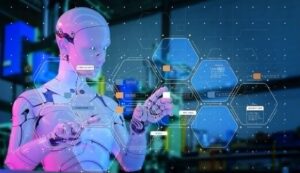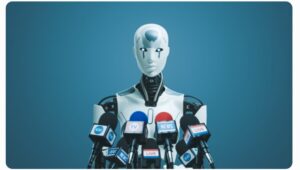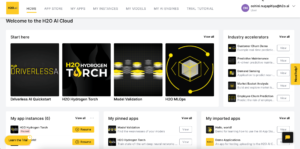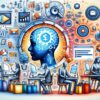Generative AI examples
8 useful generative ai examples in 2025.
As generative AI technology has advanced, its applications have become increasingly transformative across multiple industries. By 2025, generative AI is far more than just a trend; it’s an integral tool in creative, business, and scientific fields.
From automating content creation and enhancing customer service to creating innovative healthcare solutions, generative AI opens up exciting new possibilities. Here, I’ll cover five impactful examples of generative AI in action in 2025, showcasing its versatility and value in various fields.
1. Personalised Customer Service Assistants
Generative AI has evolved significantly to support personalised, conversational experiences in customer service. Unlike traditional chatbots, these AI-powered virtual assistants can engage in nuanced, human-like interactions, understanding customer sentiment, adjusting tone, and even predicting user needs. By 2025, they provide tailored assistance across e-commerce, banking, healthcare, and more.
- How It Works: Using natural language understanding, these assistants engage customers in real-time, address queries, and handle complex interactions with a personalised touch.
- Use Cases:
- Retail: Assisting customers with product recommendations based on purchase history.
- Healthcare: Supporting patients with information on appointments, prescriptions, and post-visit care.
- Banking: Helping customers manage accounts, process payments, and receive financial advice.
- Example: Companies like Zendesk and Salesforce use generative AI to empower their virtual agents with advanced personalisation capabilities.
2. AI-Generated Content for Marketing and Social Media
In 2025, generative AI tools are increasingly relied upon for creating digital marketing content, from social media posts to long-form articles. These generative AI examples tool generate engaging text, visuals, and even videos tailored to specific audiences, helping brands maintain a dynamic online presence without overwhelming their content teams.
- How It Works: AI systems like GPT-4 generate human-like text, while AI-powered design tools create graphics and videos based on user inputs and audience insights.
- Use Cases:
- Social Media: Generating regular, engaging posts with brand-specific voice and tone.
- Content Marketing: Producing blogs, newsletters, and email campaigns to boost customer engagement.
- Ad Campaigns: Crafting ad copy and visuals that resonate with targeted audiences.
- Example: Tools like Jasper and Canva AI support marketing teams by automating content creation, enabling businesses to scale their output effectively.
3. AI in Drug Discovery and Medical Research
Generative AI is revolutionising healthcare research by accelerating drug discovery and personalised treatment development. With its ability to simulate biological processes and predict molecular interactions, generative AI significantly reduces the time needed to develop new drugs and understand complex diseases.
- How It Works: Generative AI models simulate molecular structures and predict how they might interact with different diseases, drastically speeding up the traditional drug discovery process.
- Use Cases:
- Drug Discovery: Identifying potential drug candidates in weeks rather than years.
- Genomics: Analysing genetic data to develop personalised treatment plans.
- Clinical Trials: Predicting patient responses to medications to streamline clinical testing.
- Example: Companies like Insilico Medicine and IBM Watson Health leverage generative AI to transform the speed and efficiency of drug development.
4. AI-Powered Design and Prototyping for Manufacturing
Generative AI in 2025 has become a game-changer for the manufacturing and design industries, assisting engineers in prototyping products faster and with more precision. From automotive to aerospace, generative AI helps produce optimised, efficient designs, reducing material waste and production costs.
- How It Works: Generative design tools create multiple design iterations based on user constraints, such as material, cost, and weight, allowing engineers to test and refine prototypes virtually before production.
- Use Cases:
- Automotive: Developing lighter, more efficient car parts.
- Aerospace: Designing aircraft components with enhanced strength and reduced weight.
- Consumer Goods: Streamlining the design and testing of new products.
- Example: Autodesk Fusion 360 and Siemens NX use generative AI to produce cutting-edge, sustainable designs across industries.
5. Real-Time Language Translation and Multilingual Content Creation
In 2024, generative AI has transformed communication across language barriers. Advanced language models now enable real-time translation and multilingual content creation, making it easier than ever for businesses and individuals to connect globally. This technology is particularly valuable for education, international business, and online content.
- How It Works: Generative AI systems translate text or speech into multiple languages instantly, preserving nuances and context to create accurate, fluent translations.
- Use Cases:
- Education: Providing translated content for remote learning courses.
- Customer Service: Enabling multilingual support for global clients.
- Social Media and News: Offering content in multiple languages to broaden reach and engagement.
- Example: Platforms like Google Translate and DeepL leverage advanced generative models to deliver accurate, real-time translation services.
6. Intelligent Document Processing and Analysis
Generative AI now plays a vital role in processing and analysing large volumes of documents, such as legal contracts, financial statements, and medical records. By extracting key information and summarising content, AI-powered tools help professionals sift through data quickly and accurately.
- How It Works: AI scans and interprets text documents, identifies essential information, and generates concise summaries, making complex content more accessible.
- Use Cases:
- Legal: Contract analysis and clause extraction for lawyers.
- Finance: Quick analysis of financial statements for investment insights.
- Healthcare: Automated processing of patient records for better data management.
- Example: Tools like Ross Intelligence for legal analysis and Kira Systems for financial documentation leverage AI for precise document review.
7. Hyper-Realistic Virtual Worlds for Gaming and Training
Generative AI is enhancing the realism of virtual worlds used in gaming and professional training. By creating detailed environments and dynamic character interactions, AI makes virtual experiences more immersive and lifelike, adding value to both entertainment and professional training simulations.
- How It Works: AI generates detailed graphics, character interactions, and responsive environments that mimic real-world scenarios, adapting in real time to player or trainee actions.
- Use Cases:
- Gaming: Immersive open-world games with dynamic storylines.
- Training: Realistic training simulations for healthcare, military, and aviation.
- Education: Virtual classrooms with interactive lessons.
- Example: Platforms like Unity and Unreal Engine are integrating AI to produce expansive, detailed virtual worlds.
8. Generative AI for Personalised Learning
In education, generative AI now supports personalised learning experiences by adapting content based on individual student progress, strengths, and learning styles. This level of personalisation enhances engagement and improves learning outcomes.
- How It Works: AI analyses a student’s performance and preferences, generating customised study materials and exercises to support their learning needs.
- Use Cases:
- Tutoring: Adaptive quizzes and exercises for individual students.
- EdTech Platforms: Personalised learning paths based on real-time data analysis.
- Corporate Training: Tailored training modules to enhance skill development.
- Example: Platforms like Khan Academy and Coursera use AI to deliver personalised educational experiences, keeping learners engaged and progressing effectively.
9. Synthetic Media and Digital Twins in Marketing
Generative AI enables the creation of synthetic media—videos, images, and audio that appear authentic but are entirely AI-generated. Marketers use these synthetic characters or “digital twins” to represent brand ambassadors or even celebrity endorsements in campaigns without requiring the physical presence of the person.
- How It Works: AI tools generate high-quality synthetic media, using real-time motion capture and natural language processing to mimic real individuals in virtual environments.
- Use Cases:
- Marketing Campaigns: Digital twins for product endorsements.
- Brand Ambassadors: AI-generated spokespeople for virtual events.
- Social Media: Synthetic influencers that drive brand engagement.
- Example: Companies like Synthesia and Rephrase.ai offer synthetic media creation, providing brands with cost-effective, scalable marketing options.
Conclusion
In exploring the diverse applications of generative AI in 2025, it’s clear to me just how deeply this technology is changing the way we live and work. From personalising customer experiences to designing entire virtual worlds, AI is proving itself a transformative force across multiple fields.
Whether it’s automating complex tasks, bringing creativity to new heights, or helping us make data-driven decisions, generative AI is here to empower us in ways that go beyond traditional tools.
As we continue to embrace these advancements, I can see that the future is filled with opportunities to leverage AI not just as a support tool, but as a genuine collaborator in our endeavours. It’s exciting to think about how much more accessible, efficient, and creative our world can become.
I’m looking forward to seeing even more breakthroughs and possibilities as generative AI continues to evolve, shaping a future where technology and human ingenuity go hand in hand.


















